As fans of the Vegas Golden Knights become comfortable viewers of Stanley Cup playoff hockey, it’ll be helpful to know a bit more about their upcoming opponent, the San Jose Sharks. The Hockey Writers are here to help. We’ll go over the roster, give you a feel for the team and players, and cover some of the special situations.
As they have been under third-year head coach Peter DeBoer, the Sharks are a defense-oriented team. They feature the league’s best penalty kill and perhaps the league’s best shutdown defensive pairing. In the offensive zone, the team is driven by power forwards, usually one on each forward line. The wild card is defenseman Brent Burns, the team’s best athlete and league leader in shots on goal by a defenseman.
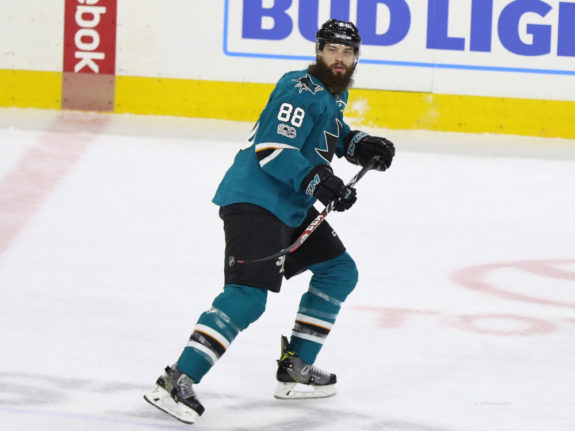
The Sharks enter the playoffs with one major injury. While no team is fully healthy, several hurting Sharks players made their way back in time for the first round series against the Anaheim Ducks and played well. The Sharks are a deep team, especially when healthy.
The lone major Sharks injury belongs to the lone guy on either roster who is a stone-cold lock to go to the Hockey Hall of Fame. Joe Thornton (No. 19) is still recovering from MCL surgery in January. It is unlikely he’ll play early in the series, he was ruled out for Game 1 even before Game 1 had a date. Still, it appears he is getting closer and it wouldn’t be a shock if he made an appearance at some point. Where he’d fit into the lineup is the subject of my colleague George Matarangas’ recent piece.
San Jose Sharks Goaltending
The Sharks are backstopped by goalie Martin Jones (No. 31). Barring injury, you can expect to see Jones play every minute of every tight game. Jones has been up and down this season, but when healthy, he’s been very strong. His save percentage (SV%) on the season is .917, but it took a major dip during times when he wasn’t healthy and during the last five games of the season. Against Anaheim, though, he was brilliant, posting a .970 SV%, among the best in NHL history for a playoff series. He gave up just four goals. Alas, there was one goalie better in Round. 1, and he plays for Vegas.
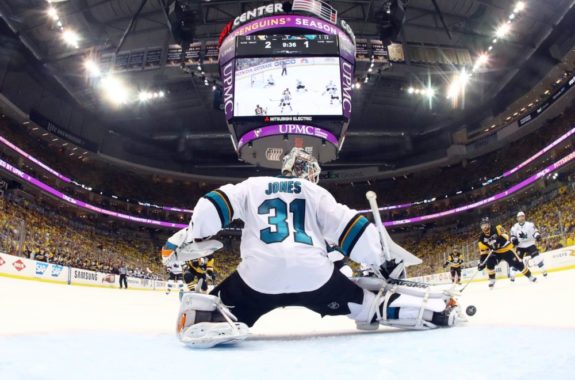
Jones has been good in the playoffs, entering this year with a .925 SV% over his career. In 2015-16, the season Jones backstopped San Jose to the Stanley Cup Final. While Jones is susceptible to overuse, the four game sweep means a lengthy break which, in turn, makes it unlikely he’ll have any such issues this series.
Backup Aaron Dell (No. 30) is very capable, though its unlikely he sees action. Dell posted a .913 SV%, but this is a bit misleading. His record was a superb 15-5-4 and a team meltdown game against Nashville (seven goals allowed) put a major dent in Dell’s numbers.
The Sharks’ Blue Line
San Jose throws challenging defenders at opponents. They are among the league leaders in points from the blue line and it’s more than just uber-talent Brent Burns.
Shutdown Pair
One set pair is Marc-Edouard Vlasic (No. 44) and Justin Braun (No. 61). They are capable of chipping in some offense. Vlasic (11 goals, 21 assists, plus-9 in the regular season) reached double-digit goals for the first time in his stellar career and Braun’s (5 goals, 28 assists, plus-7) points all came at even strength. This may have been Braun’s best season. This is the pairing which starts in the defensive zone against other team’s top lines. They might be the best shutdown pairing in the league. If they are right, nothing comes easy against them. They shut down Connor McDavid last season. Ryan Getzlaf and his line didn’t fare well in the opening round against them this season. Many consider Vlasic the team’s most important player.
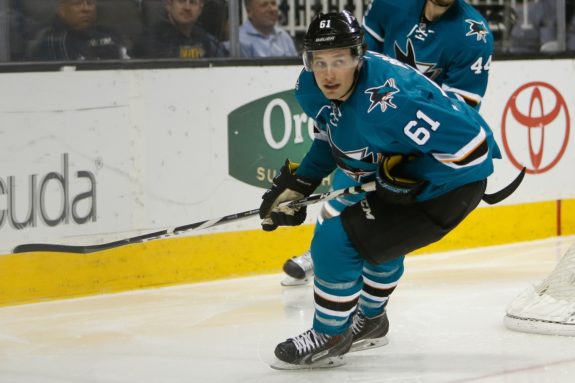
Offensive Pair
The other primary pairing features Burns (No. 88) and Paul Martin (No. 7). The 37-year-old Martin is tall and rangy. He may be the oldest Sharks player to play in the series. Martin spent the first half of the season injured and most of the second half trying to get back into the lineup. The good news, he isn’t worn down and appears to have more jump than he had last season.
Martin (two assists, plus-7 in the 11 games since returning to the lineup in March) understands the talent he’s playing with. Some have called him “the Burns whisperer” for his ability to bring out the best in Burns. Burns had a fall-off from his Norris Trophy winning season in 2016-17, but he remains a very dangerous and often dominant player with freakish athletic skills and a laser-quick wrist shot. Even in a “down” year, Burns (12 goals, 55 assists, minus-16) set a personal best in assists. The Sharks will feed Burns at the right point from where he’ll look for either shots on goal or tip plays in front. At its best, it’s lethal.
Also worth mentioning, the Sharks lost twice in regulation to the Golden Knights and both times, Burns’ defense was involved in key moments. A pair of defensive misplays by Burns helped turned a 3-2 Sharks third period lead into a 5-3 Vegas win back in February. And on March 31, the last time these teams met, another key play involved Burns. This happened with the scored tied at 2-2 and the Sharks on the power play. A poor drop pass from Joe Pavelski was the major culprit, but Burns didn’t read the play correctly and this led to William Karlsson’s shorthanded beauty, which was the difference in the second Vegas regulation win.
There is a bit of controversy with the use of the Martin over 24-year-old rookie Joakim Ryan (No. 47). Ryan is smaller, more compact and a very efficient skater. Both Ryan and Martin are very judicious in their offensive role when paired with Burns, but not afraid to seize the moment if it presents itself. Ryan (three goals, nine assists, plus-13) holds an unusual distinction; he led the Sharks in plus/minus but hasn’t made the playoff lineup.
Some think Martin’s lack of speed will expose him to the Vegas quick strike offense. While coach DeBoer won’t make changes at the outset of the series (after a sweep, why would he?), this is one to keep an eye on.
Third Pair
The Sharks’ third pairing is not usually a liability, which is nice to have in a third pairing. Brenden Dillon (No. 4) is big and strong, but his improved mobility has helped him be more successful. The more mobile Dylan DeMelo (No. 74) is locked in as Dillon’s partner. DeMelo (20 assists, minus-one) is smaller and more agile, but he’s been inconsistent. He’s been contributing points, with 12 assists in his last 18 regular season games. In DeMelo’s 130-plus game career, he’s almost exclusively been partnered with Dillon (5 goals, 17 assists, minus-7).
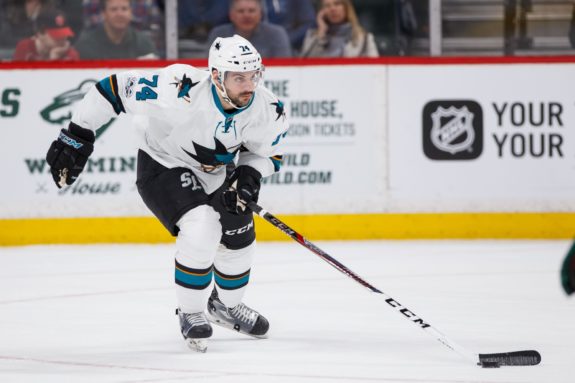
The Sharks’ blue line is capable of scoring, difficult to play against and unlikely to get sent to the penalty box. Martin and Ryan combined for only five minor penalties all season; Vlasic, remarkably, had just two. Dillon is the most likely to get into a fight, having four on the season. He even had a Gordie Howe hat trick against Calgary.
One thing you’ll almost certainly see at times, a pairing of Burns and Vlasic (mostly in the third period). DeBoer uses this at times to get extra ice time for his top two defenders, especially in close games. It isn’t a permanent move, just a frequent in-game move to attempt to tilt the ice. He’ll often go to a five-defender lineup in the third period.
The Sharks’ Forwards
San Jose’s forward groups are defined by their power forwards. The Sharks have strong, skilled players who control the puck, draw penalties and are seriously good at screening in front of the net. They can pass, score and even win a face-off. The Sharks usually use one power forward per line. The three key players (all left wingers) are Evander Kane (No. 9), Tomas Hertl (No. 48) and Timo Meier (No. 28). The fourth line’s power forward is Eric Fehr (No. 16).
While there was some guessing as to what DeBoer was planning for the Ducks, there is no guesswork entering this series.
The Top Line
One of the team’s top groups features team captain Joe Pavelski (No. 8) and the newly acquired Kane. Pavelski (22 goals, 44 assists, even plus/minus) delivered another strong season. He had a slow start but a strong finish. Kane (9 goals, 5 assists, and plus-5 in 17 games with San Jose) is a physical powerhouse with a lot of speed. Kane and Pavelski developed chemistry almost instantly and they’ve proven hard to stop. The third member of the line is Joonas Donskoi (No. 27). Donskoi (14 goals, 18 assists, plus-10) spent much of the season battling injuries. He is a terrific passer and a good compliment for the talented Kane and the savvy Pavelski.
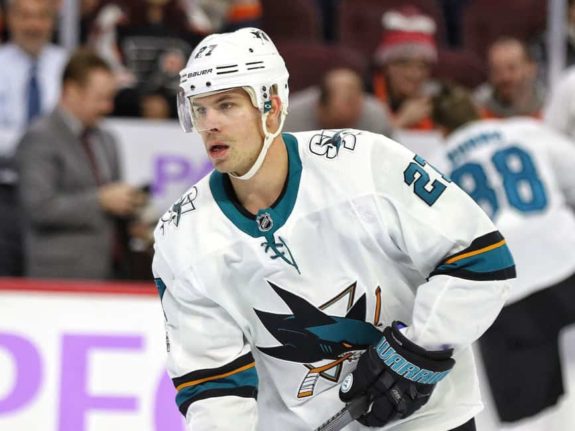
The Other Top Line
The other top group features Tomas Hertl (No. 48) and Logan Couture (No. 39). Couture (34 goals, 27 assists, minus-two) is the team’s most valuable player, and leads the team in goals. Hertl (22 goals, 24 assists, minus-two) is tied for second. While Hertl isn’t as powerful as Kane, he is strong and a difficult matchup. Mikkel Boedker (No. 89) is their current linemate. After a slow start in San Jose which reaches all the way back to last season, the speedy Boedker (15 goals, 22 assists, even plus/minus) finally got things moving in January – almost all of his production came in the 2018 portion of the season. He had a brilliant assist early in Game 3 against the Ducks (when it was still close), blazing past their top defender, making a sharp turn to the net and helping create a 3-on-1 break.
Third Line
The third line features Chris Tierney (No. 50) at center. He had a fine series against the Ducks, as described in this linked article. Tierney (17 goals, 23 assists, even plus/minus rating) is a setup man with a creative passing game and is coming off his best season. His left winger is Timo Meier (No. 28) while Kevin Labanc (No. 62) is on the right. Meier (21 goals, 15 assists, plus-two) is a powerfully built man-child sort, and at age 21 is the youngest player on the roster. He is another player who had a much stronger second half of the season. Labanc (11 goals, 29 assists, minus-6) is a smaller, crafty player who is often unnoticed. Unlike Meier, you’ll see Labanc getting pushed off the puck at times. Labanc’s at his best on the power play where he earned 17 of his 40 points.

Fourth Line and the Rest
Eric Fehr centers the fourth line. He spent much of the season playing for the San Diego Gulls, the Ducks’ AHL affiliate. The veteran has been solid for San Jose (three goals, assist, plus-seven in 14 regulars season games) and is yet another physical presence. He powered his way to goal in the series against the Ducks. He’ll be joined by Marcus Sorensen (No. 20) and Melker Karlsson (No. 68).
Karlsson (8 goals, 11 assists, minus-5) is the Sharks’ most disruptive forechecker, but he had a down season. He’s not fully healthy; his frequent “maintenance days” (team practices where he gets the day off) are an indicator. In his case, injuries lead to inconsistency from game to game. The added rest between series probably helps him more than most other players. When DeBoer juggles lines, it often involves Karlsson.
Sorensen (five goals, two assists, minus-5) is the quickest Sharks player and was a surprise starter against the Ducks, And he delivered a massive series, scoring three goals, adding an assist and at times, seemed like the player Anaheim had no answer for.
The Sharks’ depth is really good, and watching the opening round series were Jannik Hansen (No. 36), Joel Ward (No. 42) and Barclay Goodrow (23), all NHL quality forwards.
Ward (five goals, seven assists, minus-two) had his least productive season in the last decade. The oldest Sharks player aside from Thornton, Ward is clearly on the downside of his fine career. Still, he’s provided playoff heroics before. Gritty veteran Hansen (two goals, 12 assists, plus-two) went nearly a year between goals, but had an uptick in his game in the regular season’s closing weeks. Goodrow (seven goals, seven assists, plus-one) is another powerful left-handed winger. Injuries kept him out of the lineup at times, but when healthy, he was consistently effective at even strength and excellent on the penalty kill.
The San Jose Power Play
The Sharks’ power play feasted against Anaheim with six goals in four games, but this might be more illusion than reality. It was an odd series on this front. The first Sharks power play goal came 5-on-3. They added four more in Game 3. They were the last four goals of the game where the final score was 8-1. It’d be nice to attribute the power play scores to highly-skilled work by the Sharks, but Anaheim meltdowns probably deserve a major piece of the “credit.”
During the regular season, the power play sizzled with a healthy Thornton (25 goals in 25 games before his injury), but had a massive drop-off in his absence. A strong power play serves a deterrent to highly aggressive even-strength play, and anything which moderates Vegas’ aggressive style can to help San Jose.
Burns is the power play quarterback, but he’s been an awkward fit in this role. He’ll often play on both the top unit and second unit, playing almost the entire time. Labanc, Couture and Pavelski are also on the top unit. The final spot belongs to Hertl (most recently) or Kane.
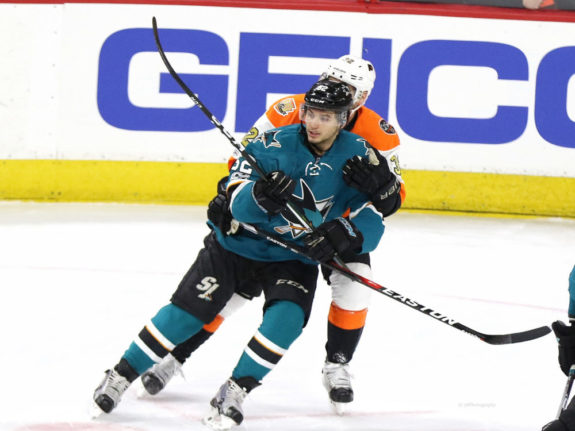
Penalty Kill
The Sharks penalty kill has been terrific, giving up a power play goal to opponents in only six of its last 25 regular season games (bizarrely giving up three in a game to Vancouver). The Sharks do not take a lot of penalties and they tend to lock it down when they are short-handed. Even 5-on-3 scoring isn’t easy against this bunch. Burns, often a liability at even strength, is very strong on the penalty kill. Tierney and Karlsson are among the top forwards in this role.
The Sharks’ Transitions
This has been a year of transition with many younger Sharks players taking important steps in their growth as players. Tierney, Meier, Labanc, Goodrow and DeMelo all took major steps forward. Ryan, as a rookie, was incredibly sound. Meanwhile, players like Braun and Boedker had much stronger seasons than last year. A lot of Sharks exceeded expectations.
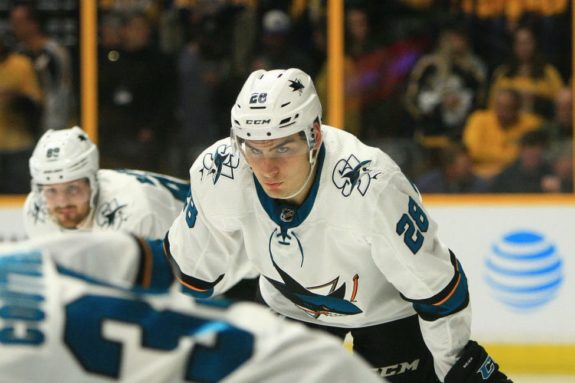
The Sharks have transitioned to a new identity around their power forwards. The acquisition of Kane and the growth of Meier added to the already physical Hertl. It has changed the team. The three are all very hard to move off the puck, they draw penalties and know how to score, each posting over 20 goals on the season. And they’ll all be on different lines, making it hard to match up defenders.
How the Sharks Win
For the Sharks, it usually boils down to defense and goaltending. The Sharks must allow few odd-man rushes, because once they get their defense set, scores are few and far between. Martin Jones has been good in the playoffs over his career and was terrific in Round 1. The Sharks don’t need a lot from the power play, we’ll see if the success against Anaheim was a new normal or an aberration.
The Sharks need to generate offense from the point, especially from Burns. Even though the Sharks are not a high scoring team, they are among the league leaders in points coming from the blue line. The forwards need to control the puck and the Sharks have the big, talented players capable of doing this.
Expect the Sharks to matchup with the dangerous Vegas top line. They’ll use the Vlasic-Braun defensive pairing. Though they can handle bigger and more physical opponents, they are especially good at neutralizing speed. This will be fun to watch.
DeBoer’s history is to juggle lines with some frequency. He’ll be looking for a boost and he has a good track record this season when making this sort of in-game adjustment. Against Anaheim, however, he ran out the same four lines all game, every game. The Sharks third and fourth lines were important and effective assets in the opening round series.
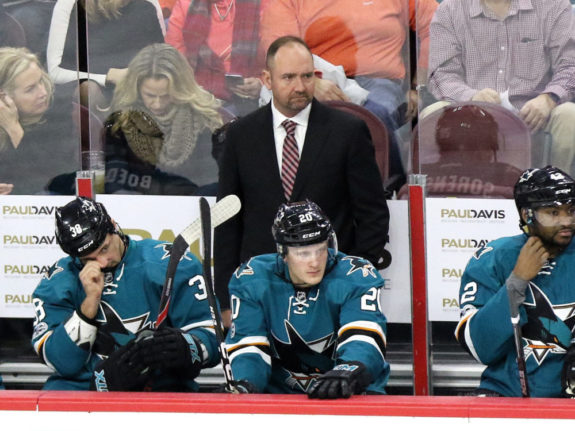
The ultimate key for San Jose is consistency. The team can play at a high level and are good enough to beat anyone. But can they keep playing at a high level long enough, consistently enough? The answer probably determines their fate.
Many think the Sharks beat Anaheim because of their speed game. I differ a bit; I think it was more poise than speed. No doubt the Sharks played faster, but Anaheim also made it too easy at times. It’s tempting to read a lot into the Sharks’ series win over the Ducks; the statistics do paint a wonderful teal-tinted picture. But I’m a bit more of a skeptic—the Ducks played with little poise and not much focus, at times giving away goals and even games. This won’t happen against Vegas, which should make this a better and more interesting series.